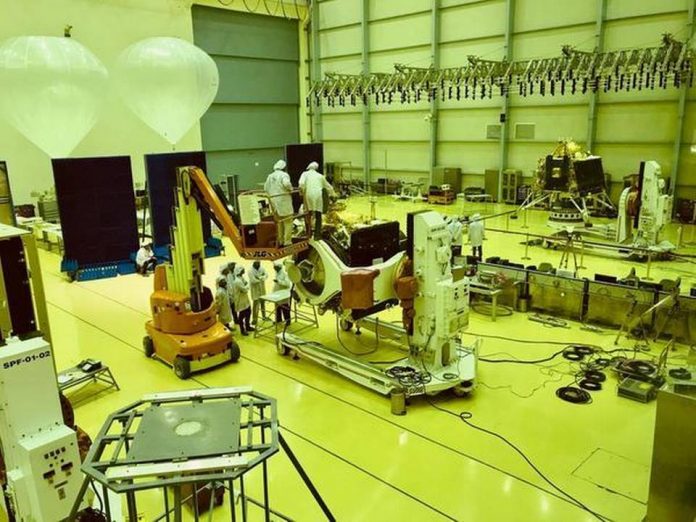Chandrayaan-2, the most complex mission yet for the Indian Space Research Organisation (ISRO), will be launched on July 15 at 2:51 hours. The total cost of the mission is close Rs 1,000 crore, including Chandrayaan-2 spacecraft and the GSLV launch vehicle.
ISRO typically hosts a live video stream of the launch that can be accessed from their webpage. You can also look for launch coverage on the YouTube page of India’s national broadcaster, Doordarshan.
If everything goes according to plan, the launcher will inject the spacecraft into an elliptical earth parking orbit with a perigee, or low point, of 170 kilometers and an apogee, or high point, of 40,400 kilometers. A series of orbit raising maneuvers will progressively raise the apogee of the spacecraft until it can be captured by the Moon’s gravity with an engine burn. Chandrayaan-2 will then perform a series of orbital maneuvers to reach a circular, 100-kilometer orbit around the Moon. The next phase of the mission involves separating the Vikram lander unit from the orbital unit of the spacecraft, and landing Vikram near the Moon’s south pole on 6 September 2019. The third phase of the mission involves the roll out of the Pragyan rover from the Vikram lander, and a subsequent 14-day mission for the rover involving various experiments.
The GSLV-MK3 launcher has already been integrated in the Vehicle Assembly building at the Satish Dhawan Space Center at Sriharikota on the eastern coast of India.
Chandrayaan-1
Chandrayaan-2 is India’s second mission to the Moon. The first, Chandrayaan-1, was launched on 22 October 2008, and included an orbiter and a Moon impact probe—a small module that separated from the orbiter and impacted the Moon near Shackleton crater. The orbiter included several scientific instruments for creating a three-dimensional map of the Moon and analyzing its mineral composition. The spacecraft went into orbit around the Moon on 8 November 2008, and the Moon impact probe crash-landed on 14 November 2008. The instruments in the orbiter were subsequently activated, and operated normally for the next 10 months.
While it did not complete its mission life of 2 years, the Chandrayaan-1 mission had several achievements. It was the first interplanetary mission for ISRO, and heralded the way for other missions to follow, including one to Mars, and the upcoming Chandrayaan-2 mission. Its most significant scientific achievement was the discovery of water on the Moon. First, a mass spectrometer on the Moon Impact Probe detected water in the thin lunar atmosphere. Then, the Moon Mineralogy Mapper instrument, developed by NASA and carried on the orbiter, detected water ice on the surface near the lunar poles. Additionally, the mini-SAR synthetic aperture radar developed by NASA and carried on the orbiter also found evidence consistent with the presence of water ice at the lunar north pole. Other achievements of the mission include the creation of detailed three-dimensional maps using over 70,000 images taken by its cameras, a study of the process by which water may form on the Moon, and a study of past tectonic activity on the Moon.
Chandrayaan-2
The Chandrayaan-2 mission is ISRO’s second mission to the Moon, and the agency’s third interplanetary mission after Chandrayaan-1 and the Mars Orbiter Mission, which launched in November 2013 and entered Mars orbit in September 2014.
Chandrayaan-2 consists of three main components. The first, also with the same name as the overall mission, is the orbiter. This will carry the other two components and will be placed in a circular lunar orbit, at an altitude of 100 km above the lunar surface. The second is the Vikram lander, which will be soft-landed on the surface, and will carry a set of instruments to conduct scientific experiments. The third will be the Pragyan rover carried aboard Vikram, which will be deployed onto the surface. This autonomous vehicle will carry its own set of instruments to conduct experiments over a planned 14-day life span.
The landing site for Vikram and Pragyan is near the lunar south pole, at about 70° south latitude, though other reports have indicated landing sites even closer to the south pole.
The Chandrayaan-2 orbiter, which will weigh 2,379 kilograms at launch, will carry a propulsion module including a liquid propulsion engine and onboard fuel for raising its orbit from the initial elliptical earth parking orbit in which it will be placed after launch. A series of orbit raising burns of its liquid engine will raise its orbit until it reaches a lunar transfer trajectory, where its orbit will bring it close enough to the Moon to be captured by lunar gravity. A series of burns will then lower its orbit to a 100-kilometer circular lunar orbit. The engine onboard the orbiter will also be used for maintaining this orbit during the course of the mission.
The second function of the orbiter will be to carry the lander-rover module and release it for its soft landing. A high-resolution camera aboard Chandrayaan-2 will image the planned landing site to help fine-tune the landing phase of the mission. It will also carry communication equipment to facilitate communications between the lander and rover, and the mission control center on earth. The orbiter’s primary mission will last 1 year.















